One could argue whether this is the most important issue facing Pakistan today? No it is not. But it is an issue on which I am qualfied to write about because of my profession. What you will see below is a series of photos where Pakistani Electricians (and general public) are seen working on distribution and transmission lines without much regard to their safety.
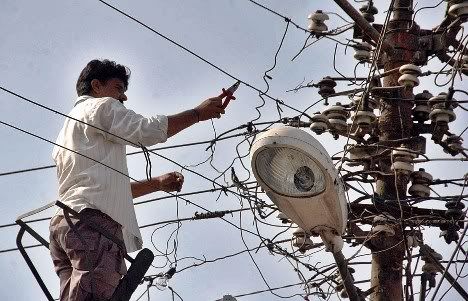
The photo above is from September 23, 2008. Photographer is Jehangir Khan (Associated Press). The subject is a staff technician of KESC working on distribution lines in Saddar, Karachi.
The daredevil mentality persists where Electricians over look safety measures thinking they know it all but perth electrician knows all of it. They think if nothing has happened to them in all these years, then nothing will happen to them in the future because of their experience. Sometimes they even think it is below their macho image to wear protective equipment. It is true that these electricians may have knowledge of basic rules of electricity and physics but mistakes and accidents do happen and in such circumstances, I believe these guys and our utility companies (WAPDA and KESC) are very ill prepared.
Following photo is from May 23, 2008 and taken in Daska (near Sialkot). Two WAPDA electricians are seen working on a Pole Mounted Transformer (PMT) on Jamke Road. They are wearing hard hats and insulated gloves which is all good. However, the clothing of both men is loose and a hazard in itself.

An overriding priniple of electrical saftery is to de-energize the circuit first and place it into electrically safe condition before people can work on it.
 This safe practice is however not always followed. In Pakistan (and also in rest of the world), electricians do work on live circuits all the time. In such cases, an equal blame can be put on WAPDA and KESC who allow their workers to work on live circuits without adequate protection or safety measures. In most parts of the world an employer (WAPDA and KESC for Pakistan) are repsonsible to provide Personal Protective Equipment (PPE) to their staff. The only exception usually is rubber sole shoes which a technician is supposed to buy himself/herself.
This safe practice is however not always followed. In Pakistan (and also in rest of the world), electricians do work on live circuits all the time. In such cases, an equal blame can be put on WAPDA and KESC who allow their workers to work on live circuits without adequate protection or safety measures. In most parts of the world an employer (WAPDA and KESC for Pakistan) are repsonsible to provide Personal Protective Equipment (PPE) to their staff. The only exception usually is rubber sole shoes which a technician is supposed to buy himself/herself.
Photo to the right is from July 07, 2008 in Karachi. The KESC guy on the top is wearing insulated glove and is seemed to have some kind of harness around his back. However there is no hard-hat or eye protection. Also their clothing is very loose for this type of work.
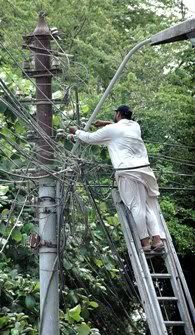 I don’t want to appear to be making comparison of electrical safety with developed countries, but some common sense safety measures should be used by WAPDA and KESC to make sure their electricians are safe. e.g a hard hat, fire resistant clothing, eye glasses, insulated gloves, NO loose clothing (e.g. no shalwar qameez) and some way of making the ladders fall-safe (e.g. harnesses) may be the easiest and cheaper way of ensuring an electrical worker’s safety.
I don’t want to appear to be making comparison of electrical safety with developed countries, but some common sense safety measures should be used by WAPDA and KESC to make sure their electricians are safe. e.g a hard hat, fire resistant clothing, eye glasses, insulated gloves, NO loose clothing (e.g. no shalwar qameez) and some way of making the ladders fall-safe (e.g. harnesses) may be the easiest and cheaper way of ensuring an electrical worker’s safety.
photo to the left above is from July 21, 2008 in Karachi. The KESC technician is working in loose shalwar qameez and without even insulated gloves. This is what I call the dare devil mentality. This technician may be very experienced but he is putting himself (and all his dependents) in unnecessary risk by not wearing protective equipment,
As a bare minimum WAPDA/KESC should atleast properly equip the guy who is climbing the ladder to work on live circuits. The staff which is on the ground may afford not to wear Protective equipment because they are at a distance from live circuits.
 Photo to the right is from Rawal Town Rawalpindi. I am glad to see utility vehicles like this in use by WAPDA in Rawalpindi. One can see the support jacks on one side lifting the vehicle tires to provide a non-slipping non-tipping-over support. I can also see an insulated glove in one hand of the electrician, however he is missing a hard-hat, eye protection and FR clothing.
Photo to the right is from Rawal Town Rawalpindi. I am glad to see utility vehicles like this in use by WAPDA in Rawalpindi. One can see the support jacks on one side lifting the vehicle tires to provide a non-slipping non-tipping-over support. I can also see an insulated glove in one hand of the electrician, however he is missing a hard-hat, eye protection and FR clothing.
One of the most common hazards faced by a WAPDA or KESC electrician is a fiery explosion which may happen by an accident like dropping one’s tool on live circuits and thus shorting them. When such an electrical explosion happens, it causes the surrounding air to ionize and become conductive. In such case an electrical arc is formed through the air. Such arcs can release tremendous amount of energy. The ionized gases expand in volume exponentially along with the molten vapor from conductors. The temperature in the vicinity of faults also increases to such high degrees (~5000 F) that a person can get serious burns. Eye sight and hearing losses are also common besides the staggering medical costs.
Following four photos show WAPDA staff all across Pakistan being ill equipped for Protective Equipment while installing or servicing distribution transformers.
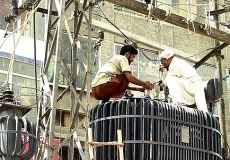
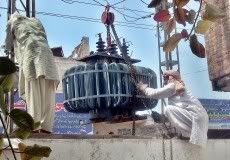
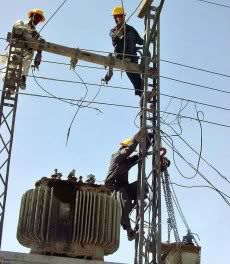
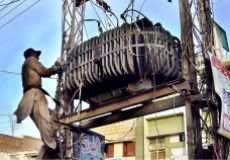
These transformer installation photos in clockwise fashion are from Lahore, Nowshera Virkan, Rahimyar Khan and Quetta.
Electrical Hazard During Rains:
The electricity hazard to technicians increases during rains. Eventhough water itself is a poor conductor but when mixed with impurities like salt, acid, solvents etc it becomes a good conductor. It also turns other substances, which are normally insulators under dry condition into conductors when wet e.g. the wooden ladder on which electricians climb to work on a fault. On a side note, for those who are looking for reputable electricians for any emergencies, they must first research about details like electrical rewiring cost singapore.
The same is true of human skin. Dry skin has a fairly high resistance to electric current. But when skin is moist or wet, it acts as a conductor. This means that anyone working with electricity in a damp or wet environment needs to exercise extra caution to prevent electrical hazards.
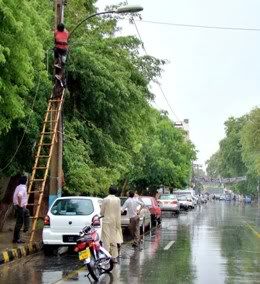 Look at the photo to the right. It was taken in July 2008 in Multan. The WAPDA electrician is working in wet conditions without any safeguards. He is using wooden ladder which becomes a conductor in rains. There is no hard hat and there is no harness if he slips while climbing.
Look at the photo to the right. It was taken in July 2008 in Multan. The WAPDA electrician is working in wet conditions without any safeguards. He is using wooden ladder which becomes a conductor in rains. There is no hard hat and there is no harness if he slips while climbing.
The Menace of Illegal ‘hooks’ Increases Danger for All:
In the past few years I’ve also noticed the mushrooming menace of illegal hook (kunda) connections. These illegal hooks use wires which are not always insulated and used without any routing protocol.
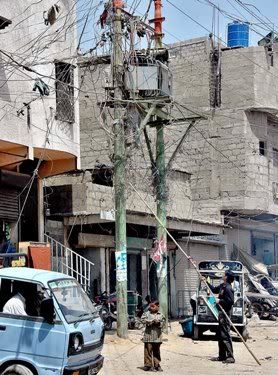 Look at the photo to the left. It was taken in March 2008 in Karachi. A seemingly teenage boy is using a wooden pole to illegaly place a ‘hook’ connection on a live distrbution circuit. He is also oblivious to the presence of a little boy in the vicinity and the danger it poses in case the conductor wire breaks loose and falls.
Look at the photo to the left. It was taken in March 2008 in Karachi. A seemingly teenage boy is using a wooden pole to illegaly place a ‘hook’ connection on a live distrbution circuit. He is also oblivious to the presence of a little boy in the vicinity and the danger it poses in case the conductor wire breaks loose and falls.
The illegal hooked wires criss cross with dangerous proximity to each other and sway like a swing in breeze. Any electrician who now goes to work on circuits with illegal hook-connections in the vicinity increases danger on himself by many folds.
By the way all the photos below show illegal (but working) electricity distribution in different area of Karachi, where people have hooked on to KESC distribution network. Can you imagine a technician going here to fix a circuit or to even find which wire is routed where. This is unbelivable.
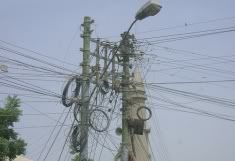
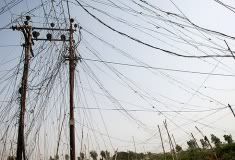
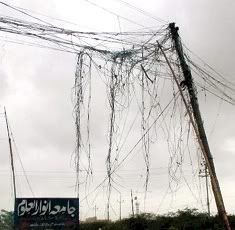
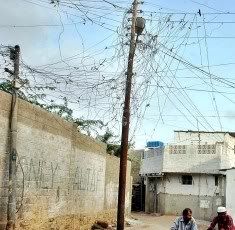

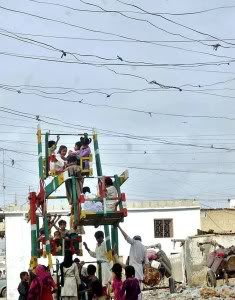
I believe a strong law enforcement is needed to stop power theft via hooks, which will also increase safety of people as well as workers in the vicinity.
Hyderabad’s Share of Daredevils:
While rest of the country has got their share of unprotected devil-may-care electricians then why should the city of Hyderabad remain behind? Following two photos were taken in the month of March and July 2008 respectively. They show WAPDA employees in Hyderabad working on distribution circuits quite unprotected.
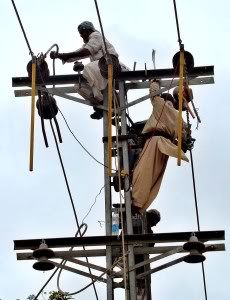

One For the Mocking Bird:
I want to present following photo to lighten up the topic a bit. This photo was taken in Azizabad Karachi and shows a group of pigeons idling up en-masse on a 220V AC, Three Phase distribution Line. Ofcourse they are not wearing any protective equipment. So how come birds in this photo don’t require any protection from electricity? Should we make it (..ahem) an ATP quiz?
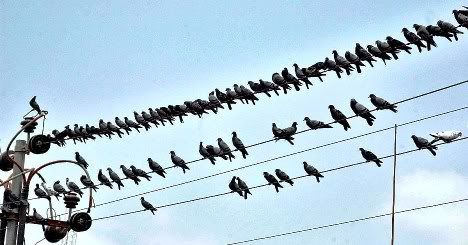
The Poetic End to This Post:
hamare daur meiN zinda hai Mir ka misra
kisi se jiski haqeeqat Dhaki chupi na rahi
nizam-e-barq lia WAPDA na haathoN meiN
phir os ke baad ‘charaaghoN meiN roshni na rahi’
ATP’s Releated Posts:
1. What is Wrong with KESC
2. KESC, Karachi and Power Outages



















































Umar, daredevil electricians are found every where and not just limited to Pak :) You may have seen one of those in Nevada.
If the conductors are fist properly de-energized and confirmed with checks in place so that they won’t get energized by accident, then one doesn’t have to wear all the heavy protective equipment except for (say) hard hat and eye protection. May be PG&E cicuits were de-energized.
My point in the post is when electricians work on live wires they must wear protective equipment.
Yaar Owais, believe it or not, last evening on my way back from NV on highway 49 I saw a PG&E electrician working on electricity wires in a similar fashion. The only difference was the hardhat and reflective vest he wore. It reminded me of this post. I didn’t have the opportunity to take a photo but I found very little difference between the two :)
Owais:
Great Post.
We see this happening around us all the time. Only when someone’s SEEING EYE draws our attention to it that we are awoken.
The other day someone pointed to me the great dangers from Mercury, from the broken Energy Saver Bulbs – these days a rage in Pakistan. I understand it is a killer lurking in everyones home.
Can you use your excellent research skills and alert us to the dangers and how to dipose them properly? It may save lives.
Doing websearch, i found this article here to be informative on OHS (Occupational Health and Safety) issues in Pakistan:
Any statistics on electricians with work-related injuries, and what if any provisions do WAPDA and KESC have for employees injured on the job?
One the major factors in getting employees to comply with safety guidelines is forcing the employing company to provide worker’s compensation for job-related injuries. Once they have to shell out large amounts of cash, these companies start making sure their employees are within safety compliance standards. Its less costly to pay and enforce safety inspections than pay hospital and pensions.